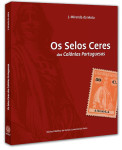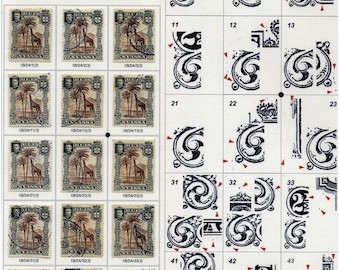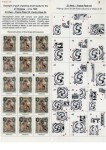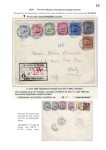Major bulletin index update
Our Editor, Ron van der Holt, has added over 20 issues to the bulletin index, which means it now includes all 1200+ articles that appeared from the first to the latest bulletin (number 209).
Our Editor, Ron van der Holt, has added over 20 issues to the bulletin index, which means it now includes all 1200+ articles that appeared from the first to the latest bulletin (number 209).
 Núcleo Filatélico do Ateneu Comercial do Porto (NFACP) has published a book on the Ceres stamps of the Portuguese overseas territories. It can be ordered from the NFACP for 15€. Postage is 1€ to Portugal, 4€ to Europe and 6.50€ to the rest of the world.
Núcleo Filatélico do Ateneu Comercial do Porto (NFACP) has published a book on the Ceres stamps of the Portuguese overseas territories. It can be ordered from the NFACP for 15€. Postage is 1€ to Portugal, 4€ to Europe and 6.50€ to the rest of the world.
The book’s author, J. Miranda da Mota, writes:
This work is an long-standing personal project that began to take shape after the publication of the book “Ceres de Portugal”(1) written in collaboration with my erudite friend of fond memory Eng. Armando Vieira.
Time has passed and now the opportunity has come to bring my project to fruition. The genesis of the Ceres stamps from the Portuguese colonies was set out in my article published in 2010(2) and now this analytical study, based on the observation of thousands of stamps, characterises the different Ceres issues from all the overseas territories of Portugal, starting with the issues of Regular Postage up to the Postage Due and Postal Tax issues, covering the period 1913 to 1949.
This book is organised in several parts. In the first, there is a summary of the different issues from each territory, highlighting the moment when the first stamps with retouched die appeared. These stamps are described along with the start of the new type for Cabo Verde, Guiné, S. Tomé e Príncipe e Angola (1932-1946), printed on “Cruz de Cristo” watermarked paper.
In the second part, a detailed description of the various types of paper is given, together with the corresponding classification, in order to facilitate correct identification. This comprises a list of tables by territory and by issue incorporating the types of paper for each stamp. This classification goes far beyond the basic types referred to in the “Selos Postais das Colónias Portuguesas” Catalogue(3), not having previously been studied in these terms. The tables also include the catalogue number, perforation, face value, quantities printed, colour, number of stamps per sheet, and also for each star position its localisation in the sheet and the corresponding quantity printed by paper and perforation.
Almost all of these frames are complemented by notes on varieties of cliché, printing errors, quantities printed; defects in stars, stamps which were surcharged or were overprinted, forgeries, and clandestine stamps. In the first table of each issue of stamps on watermarked paper of the four colonies mentioned above, there are only general references to the dislocation of the printing of the value which, as is known, appeared in the second printing and to small varieties of cliché that were not included in the general list of varieties as they are relatively insignificant.
The penultimate part of the book is devoted to varieties of cliché and printing errors and contains the most important varieties prior to the Ceres new type.
The book ends with a list of the characteristics of the different compositions of the printing plates (chases of clichés) with, for each, the location of the varieties on the sheet and the number that corresponds to them in the list of varieties.
Given the results of this study, particularly in respect of papers, varieties of cliché and some stars positions, the catalogue “Selos Postais das Colónias Portuguesas”, now published by Mundifil, may be updated accordingly in an upcoming issue.
1 MOTA, J. M. e VIEIRA, A. M. O. (1992). Portugal Ceres – Variedades de Cliché. Afinsa, Lisboa.
2 MOTA, J. M. (2010). O Primeiro Selo da República em Portugal e Colónias. Catálogo da Exposição Mundial “Portugal 2010”. CTT, Lisboa.
3 Catálogo de Selos Postais. Colónias Portuguesas, 7.ª edição (2015).

 John Dahl has kindly made available to PPS members his five frame exhibit on the Nyassa Company, to be shown at LONDON 2015 next week. The exhibit received Large Gold at LUBRAPEX 2009 in Évora, Gold at STAMPEX 2010 in London and Large Vermeil at JOBURG 2010 in Johannesburg.
John Dahl has kindly made available to PPS members his five frame exhibit on the Nyassa Company, to be shown at LONDON 2015 next week. The exhibit received Large Gold at LUBRAPEX 2009 in Évora, Gold at STAMPEX 2010 in London and Large Vermeil at JOBURG 2010 in Johannesburg.
 For LONDON 2015, John has ditched the first frame, with 19th century stamps and covers, and added a new fifth frame about the 1918 local surcharges on the 1901 issue. In this way, the exhibit became more coherent, dealing only with the “Camels and Giraffe” issue, the new frame confirming the conclusions of the first four frames as to which printings were sent Nyassa for postal use. John writes:
For LONDON 2015, John has ditched the first frame, with 19th century stamps and covers, and added a new fifth frame about the 1918 local surcharges on the 1901 issue. In this way, the exhibit became more coherent, dealing only with the “Camels and Giraffe” issue, the new frame confirming the conclusions of the first four frames as to which printings were sent Nyassa for postal use. John writes:
“Over 50 years’ fascination and original research has finally revealed the surprising secrets of this seemingly common issue, that was the pride of every schoolboy’s collection. As well as unique Die Proofs this 5-frame exhibit details the Waterlow & Sons recess printing method. Based on the Waterlow archive, containing some 180 complete sheets, plating studies have revealed that 7 printings of the 1901 issue were made, including two reprints in 1922. Well over 90% of the stamps printed were never sent to Nyassa, but outlet onto the philatelic market in London, including the two printings with inverted centres. Nearly all ‘used’ examples were cancelled to order in London; indeed genuinely used examples (if you can recognise them!) are much rarer than their catalogue value suggests. The rare covers have provided vital evidence in determining the printings which were sent out to Nyassa for postal use.”
Click on the images to see the plans of the exhibit and of its original first frame with 19th century material. The LONDON 2015 exhibit Read More